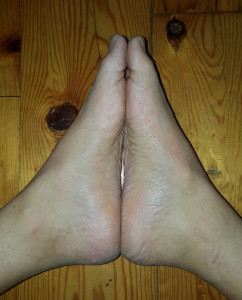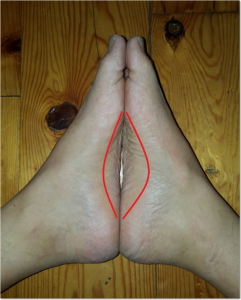How much time do you spend looking at your feet? Me? I look at my feet a lot. And I look at other people’s feet just as much.
A yoga teacher that isn’t interested in and fascinated by feet wouldn’t make much sense to me.
The human foot has twenty-six bones with thirty-three possible articulations— if the foot works well. I don’t have a number but I can’t imagine a large percentage of the population is working and moving their feet quite as much as they could.
Shoes and the level ground of modern terrain are the main culprits for feet that don’t work as well as they should. Posture and core tone also play a fairly substantial role in how well the feet work.
There are three arches— inner, outer, and transverse— in each foot.
Technically, the transverse arch is more of a support system than an arch, and the outer, or lateral longitudinal, arch is relatively flat.
The inner, or medial longitudinal, arch gets much of my focus.
The inner arch is the weight-bearing arch.
When things are going well posturally the weight of the body is transmitted through the tibia (one of the bones of the shin) to the talus (a bone of the foot) and then distributed backward into the heel and forwards to the forefoot.
Most of the weight that moves forward does so through the inner arch.
The arches are formed by the tone of the many ligaments holding the bones of the feet together and the muscles of the calf that lift the arches on demand.
The easiest way to feel this is to lift the toes. You should be able to see and feel two specific things—when the toes lift the inner arch lifts and at the same time the muscles of the outer calf (fibularis) tone.
All of this was to introduce the picture at the top of this post.
In general, I have good arches and have never had any foot problems; lots of sprained ankles due to loose ligaments but nothing that has been debilitating.
But last night I was stretching while my class was in savasana (is that bad?).
As an aside, I love doing wheels after teaching and often do them while the class is resting (again, is that bad?).
Last night, I was doing a different series of poses that I enjoy—upavista konasana, tarasana, and baddha konasana— and often teach students to finish class.
Anyway, looking at my feet in baddha konasana I couldn’t help but notice the difference in the inner arches of my feet.
My left foot is, dare I say, perfect.
My right foot on the other hand is way too high for my liking.
This is not news to me but seeing it in a different light is always interesting.
I have a tight right psoas and that foot tends to turn out. The tight psoas is why that arch is pulled up higher than the left.
Take a gander at your feet today see what you see.


